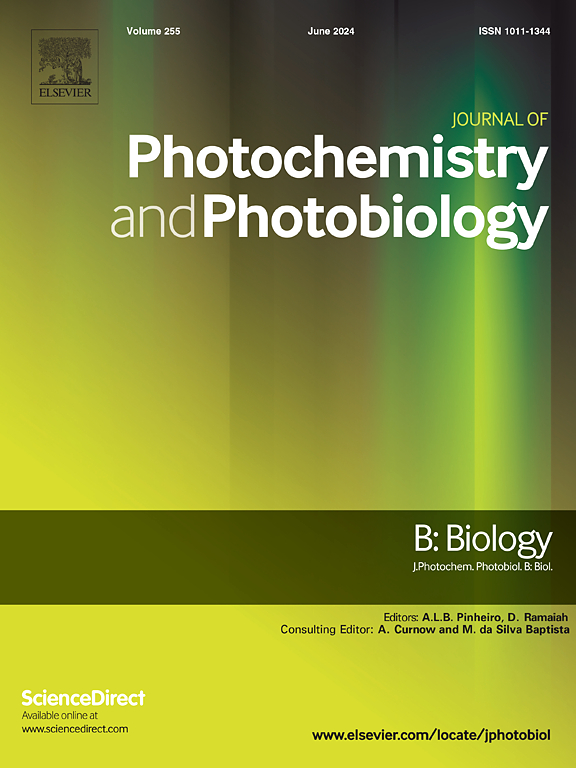Wavelength-dependent excitation ratio of photosystem I and II in Arabidopsis thaliana
IF 3.7
2区 生物学
Q2 BIOCHEMISTRY & MOLECULAR BIOLOGY
Journal of photochemistry and photobiology. B, Biology
Pub Date : 2025-10-06
DOI:10.1016/j.jphotobiol.2025.113278
引用次数: 0
Abstract
Photosynthesis is a finely tuned process in which plants balance excitations between photosystem I (PSI) and photosystem II (PSII) to optimize energy conversion efficiency. The distribution of light energy between PSI and PSII across the full spectrum of photosynthetically active radiation is hard to quantify. Current attempts rely on estimating the PSI/PSII reaction center ratio and PS antenna sizes. In this study, we employed a streak-camera system to measure excitation distribution between PSI and PSII in Arabidopsis thaliana leaves over the wavelength range 430–630 nm, bypassing the need for indirect estimations of antenna size and pigment distribution. Our findings show that the absorption weighted PSII/(PSI + PSII) excitation ratio is 0.60 ± 0.01 in the 430–630 nm spectral range. By fitting the excitation spectrum with absorption spectra of PSI, PSII, and LHCII, we estimate the PSII/(PSI + PSII) reaction center ratio to be 0.58 ± 0.004. The excitation ratio shows that in the dark-adapted supercomplex organisation, PSII is overexcited. By recording a light response curve of ΦPSI and ΦPSII, we determined that the dark-adapted supercomplex organisation leads to overexcitation of PSII in low to medium light illumination intensities (∼372 μmol m−2 s−1). However, state transitions alone can rebalance the charge separation ratio. The quantitative excitation ratio and its correlation with reaction center ratios provide crucial parameters for refining photosynthetic models and understanding energy distribution across photosystems.
拟南芥光系统I和II的波长依赖性激发比
光合作用是植物平衡光系统I (PSI)和光系统II (PSII)之间的激发以优化能量转换效率的精细调节过程。在整个光合有效辐射光谱中,PSI和PSII之间的光能分布很难量化。目前的尝试依赖于估计PSI/PSII反应中心比和PS天线尺寸。在这项研究中,我们利用条纹相机系统测量了拟南芥叶片中PSI和PSII在430-630 nm波长范围内的激发分布,绕过了间接估计天线尺寸和色素分布的需要。结果表明,在430 ~ 630 nm光谱范围内,吸收加权PSII/(PSI + PSII)激发比为0.60±0.01。将激发光谱与PSI、PSII和LHCII的吸收光谱拟合,得到PSII/(PSI + PSII)反应中心比为0.58±0.004。激发比表明,在适应黑暗的超复杂组织中,PSII被过度激发。通过记录ΦPSI和ΦPSII的光响应曲线,我们确定了适应黑暗的超复杂组织导致PSII在低到中等光照强度(~ 372 μmol m−2 s−1)下过度激发。然而,状态跃迁本身可以重新平衡电荷分离比。定量激发比及其与反应中心比的相关性为完善光合模型和理解光系统间的能量分布提供了关键参数。
本文章由计算机程序翻译,如有差异,请以英文原文为准。
求助全文
约1分钟内获得全文
求助全文
来源期刊
CiteScore
12.10
自引率
1.90%
发文量
161
审稿时长
37 days
期刊介绍:
The Journal of Photochemistry and Photobiology B: Biology provides a forum for the publication of papers relating to the various aspects of photobiology, as well as a means for communication in this multidisciplinary field.
The scope includes:
- Bioluminescence
- Chronobiology
- DNA repair
- Environmental photobiology
- Nanotechnology in photobiology
- Photocarcinogenesis
- Photochemistry of biomolecules
- Photodynamic therapy
- Photomedicine
- Photomorphogenesis
- Photomovement
- Photoreception
- Photosensitization
- Photosynthesis
- Phototechnology
- Spectroscopy of biological systems
- UV and visible radiation effects and vision.

 求助内容:
求助内容: 应助结果提醒方式:
应助结果提醒方式:


